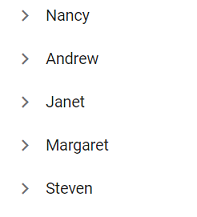

If you set the ShouldRender field of the event arguments to true, the component will re-render after the event (it will call StateHasChanged()). For example, the BuildRenderTree for the standard Pages/Index.razor page looks like this. Blazor components create this Virtual DOM in its Razor views via a virtual method named BuildRenderTree. The OnItemContextMenu is used to integrate the Context menu to the TreeView node. This data creates a tree of HTML elements as if they had been specified by an HTML mark-up page. You can use the event arguments to determine the keyboard key or the position of the mouse cursor when the user took an action. The component can be used to simplify navigation within a. It maps to MouseEventArgs or KeyboardEventArgs depending on the user's action (clicking the row with the mouse/tapping it on a touch device, or pressing Enter when the row is focused). The DevExpress TreeView for Blazor displays hierarchical data structures within a tree-like UI. The event arguments expose an EventArgs property. You can set this to any CSS value that the attribute height. If not set, it will try to grow in height.

The event handler receives a TreeViewItemContextMenuEventArgs object which provides the model of the clicked row in the Item field that you can cast to your model type. The Telerik TreeView for Blazor renders data in a traditional tree-like structure that shows the hierarchy between the items. Setting a height will allow to scroll the treeview. The OnItemContextMenu event fires when the user right-clicks on a TreeView node, presses the context menu keyboard button or taps and holds on a mobile device. Handle the expand and collapse event to get the user's action ") The TreeView component is meant to emulate the asp:TreeView control in markup and is defined in the .WebControls. MatBlazor - Material Design components for Blazor MatTreeView Renders the data as a tree.


 0 kommentar(er)
0 kommentar(er)
